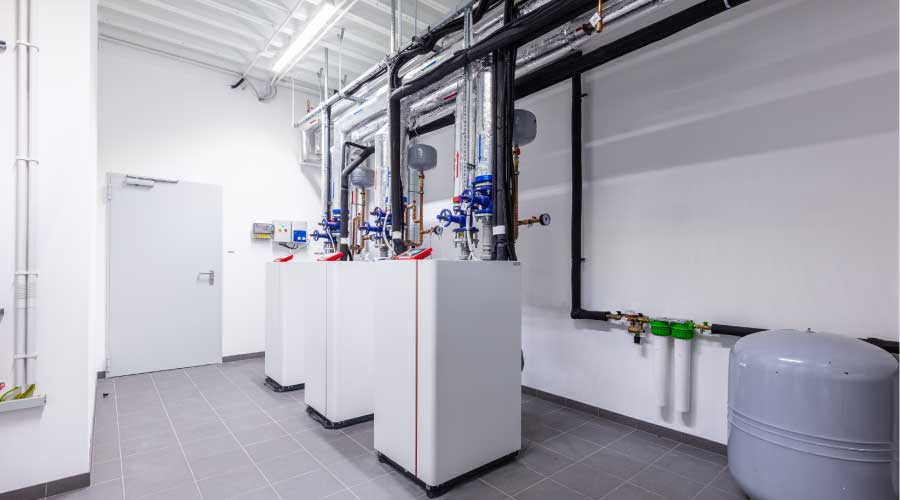Life-cycle Costs: A Closer Look
From specification and commissioning to installation and maintenance, a range of factors can affect a pump’s overall performance and cost
The process of specifying the right pump technology for an application in facilities should go well beyond first cost, but in too many cases, it does not. Such a shortsighted approach can create major, long-term problems for organizations.
Managers involved in this process need to understand the factors that contribute to life-cycle costs, including installation, commissioning, maintenance and energy. And they can use this information to develop strategies that benefit the department and the organization.
Focus on Savings
Based on case studies cited in the Pump Life Cycle Cost Guide — a joint publication of Europump and the Hydraulic Institute — energy costs can represent 90 percent of the total cost of owning a pump. Proper matching of pump performance and system requirements, however, can reduce pump energy costs by an average of 20 percent in many cases.
These high energy costs strongly suggest that maintenance and engineering managers can generate savings for the organization by focusing on the impact of energy efficiency when specifying, installing, commissioning, and planning the maintenance of pump systems.
Design and installation. Matching pumps to their intended uses begins with selecting the pump class — centrifugal, rotating or reciprocal — and the pump type because many casings are designed for specific fluid characteristics.
The specifier then must calculate the pump’s quantitative requirements, including volume, pressure, and system piping size, to minimize the friction losses. The next step is selecting the right motor and controls. By carefully tailoring design specifications to service conditions, managers can minimize the energy consumption while delivering the intended volume in gallons per minute (gpm) against the system pressure.
Commissioning. A practical operating test ensures that the specified pumps and controls will provide the service desired. It is best done in the manufacturer’s test lab. If something doesn't work right, adjustments can be made before shipping. Part of the commissioning process compares the pump and control system performance against standards for the specifications on the system component nameplates to ensure they match.
To predict life-cycle characteristics of the various parts of the system, specifiers also might want to include mechanical and electrical predictive tests, such as vibration analysis and thermal imaging. For instance, too much initial vibration in the pump shaft might translate into shorter shaft and bearing life and, as a result, higher maintenance costs. This potential problem can be corrected using a high-tensile-strength alloy or lowering the length-to-diameter ratio. Managers can refer to ANSI/HI Standard 9.6.4 for allowable vibration levels.
The tester should certify the test results, providing the buyer with greater assurance that problems due to design deficiencies will be corrected at the supplier’s expense. Some buyers prefer to retest on their site after installation to make sure parameters are the same and test results are satisfactory.
Maintenance. The pump’s operation and maintenance manual shows the normal preventive maintenance (PM) tasks and frequency and forms the basis of the annual PM schedule. Managers can use this data to determine times for performing each task, either by estimating or by using predetermined time benchmarks containing similar work content.
Multiplying a task’s time by its frequency produces the total annual PM time. Adding the total annual PM times for each task produces the total annual PM time for the pump. Besides PM, some corrective or routine maintenance is required to compensate for normal wear during the system’s life cycle.
In the case of wear rings, Hydraulic Institute data show that with two times the standard clearance the efficiency drops about seven points at a specific speed of 1,000. Periodic gap checks against design clearance specifications as a part of the PM program will show the amount of wear. The technician can replace the rings before they affect the efficiency. There also will be a corresponding head loss.
Finally, periodic motor-load ammeter phase tests versus full-load amps on the motor nameplate might show that capacity or pressure needs have changed since the initial specifications, indicating a change in the system curve. Likewise, motor temperature versus allowed degrees temperature rise on the nameplate might show motor overload.
Cutting Losses
Higher energy-use levels also might indicate in greater system inefficiency. Managers can address this challenge and generate savings from pump operations with frequent and comprehensive inspection of the following system components: hot- and cold-water pumps; condensate-return pumps; sewage pumps; boiler-room feedwater — centrifugal — pumps and water-conditioning pumps; proportioning pumps; and air conditioning and refrigeration equipment, such as cooling tower pumps.
Vigilance is the best defense in preventing minor pumping system problems from becoming big ones. By setting up a surveillance system, technicians can locate and replace a malfunctioning fixture when leaks begin. They also should keep records of problems so they can permanently fix the most frequently occurring problems first.
Retrofit Considerations
A comprehensive program of pump system inspection and maintenance — complemented by updating and retrofits to take advantage of technology innovations — can bring an organization substantial and quick returns. As problems are solved, or as improved PM inspections and upgrades eliminate frequently occurring problems, managers can redirect funds to more productive uses.
Managers also will be able to convert much of technicians’ “firefighting” time related to pump maintenance into routine, scheduled repairs that don’t interrupt students, patients or employees. If managers can determine how much of this work is available in labor hours per year, they can ensure adequate staffing or show the effects of inadequate staffing.
Also, using a computerized maintenance management system to generate, track and analyze work orders for all pump-related tasks ensures that managers have access to cumulative life-cycle maintenance costs for all labor and material related to pump system components.
If upper management resists efforts to modernize pump systems as a way to generate savings, managers should remember this: In an enterprise that nets 5 percent return on revenue, a $50,000 reduction in operating cost generates the same bottom-line profit as a $1 million increase in revenue. This relationship applies in both for-profit and not-for-profit facilities. All managers and organizations can find good uses for such savings.
The Case for Variable-Speed Pumping
Variable speed pumping (VSP) is generating interest among facilities seeking every opportunity to control energy cost and maximize system efficiency. Here are answers to three questions related to such applications:
Why? VSP curtails energy costs, flow interruptions, and pressure variations in aging water supplies and distribution systems. Alternatives, such as investing in new pumps and controls or operating throttling systems are more expensive.
How? Specify and install variable frequency drives (VFD). The torque, speed and horsepower of an AC motor are proportional to frequency and voltage. VFD controls first convert AC to DC, then invert DC into AC with variable frequencies and voltage. Inverters can be installed on any asynchronous motor. A low ratio of pump-shaft length to diameter is best to prevent shaft deflection over a range of speeds, as well as frequent stops and starts. VSP applications should minimize frequent starting and stopping.
When? The best applications for VFD pumps are those with a dominant friction head. On a volume-versus-head system curve, these applications have the best efficiency lines that lie along a large part of the exponential curve describing head varying with the square of the capacity.
Among the benefits of VSP:
-
It can reduce energy demand when less capacity is needed, rather than converting the excess energy to heat loss and throttling the flow.
-
It can deliver a range of head capacities, so estimating flow can be less exact.
-
It can eliminate the need for throttling valves, which can leak, require maintenance and waste energy.
-
It can can eliminate inefficient bypass lines.
-
It can reduce or eliminate negative heat-caused effects on fluids, which can cause fluid to vaporize or flash, crystallize, change viscosity, foul wearing parts, increase corrosiveness, change critical dimensions, or distort lapped seal faces.
|
Spotlight: Hydraulic Institute
The Hydraulic Institute (HI), established in 1917, is the largest association of pump producers and suppliers in North America with nearly 100 members. It provides companies and pump users with product standards and a forum to exchange information. HI participates in the development of international pump standards and is the spokesperson for the North American pump industry. More than 30 committees and work groups participate in standards development and other matters. Among its resources:
Standards. One of HI’s roles is the development of ANSI-approved pump standards. Currently, 25 standards cover centrifugal, vertical, rotary, reciprocating, and air-operated pumps. Standards regarding slurry, viscosity correction and controlled volume metering pumps are in development. ANSI/HI standards are available in hard copy, CD-ROM, or on the Web. A cross-reference guide and index are available on-line.
Publications. HI and Europump have developed two guides, Pump LCC: Life Cycle Costs Analysis of Pumps and Pumping Systems and Variable Speed Pumping: A Guide to Successful Applications. Summaries are available on-line.
Web-based learning. In 2003, HI launched www.pumplearning.org, which features an e-learning program, “Centrifugal Pumps: Fundamentals, Design and Applications” that addresses centrifugal and vertical pump technology and the basics of hydraulics. Developed for pump users, manufacturers, engineers, contractors, specifiers and others who work with pumps and pumping systems, it is available on CD-ROM through www.pumps.org or click for an online format.
Energy conservation. HI is an allied partner with the U.S. Department of Energy, and was a charter partner of the Motor Challenge program. In 2002, HI endorsed the NEMA Premium motor program. Many HI members have trained their staff on the Pump Systems Assessment Tool and conduct programs for pump users and distributors. Members are also defining a National Pump Systems Education Initiative to advance concepts of life-cycle cost, energy savings, and pump systems performance optimization.
Web sites. The sites www.pumplearning.org and www.pumps.org provide definitions and terminology, pump family trees, and other resources, including the ANSI/HI standards, the Pump Life Cycle Cost and Variable Speed Pumping Guides and e-learning resources.
For more information about these and other resources and activities, call (973) 267-9700 or visit the links above.
|
Related Topics:











